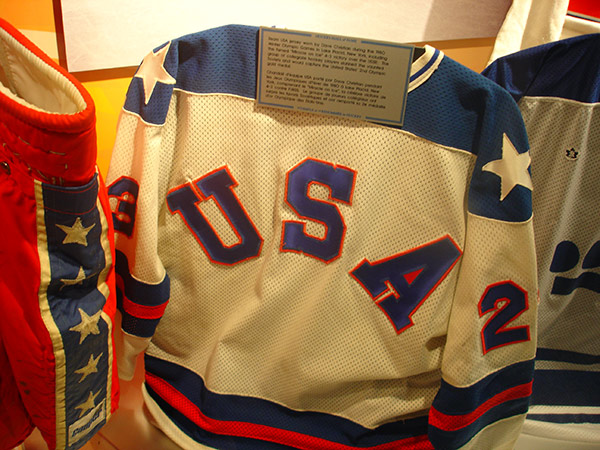40 Years Ago, the U.S. Olympic Hockey Team Made Us Believe in Miracles
The story sounds like the stuff of movies. So much, in fact, that it later became one. On one side, you had the most powerful force in their sport, a team of professionals known for their ability to crush everyone in their path. On the other, a group of college students untested in international play, primed to meet an opponent that should soundly beat them in convincing fashion. But that’s not what happened. 40 years ago, the U.S. Olympic hockey team rode an improbable streak into battle against the powerhouse Soviet Union. What resulted was one of the greatest games ever played, capped by perhaps the greatest broadcasting call in the history of sports. But it still wasn’t over. Here are five things you should know about the Miracle on Ice, including the fact that it wasn’t the Gold Medal game.
1. The Soviet Team Was a Monster
Going into the 1980 games, the Soviet team had won the gold in five of the last six Olympics. In fact, the team reigned as the preeminent power in international hockey from 1954 until the U.S.S.R’s dissolution, with 22 International Ice Hockey Federation gold medals between 1954 and 1990. The Soviet players were technically professionals, but their clubs were arranged in such a way that their player status didn’t exactly violate International Olympic Committee rules. That meant that other countries were fielding amateur athletes while the Soviets were using veteran players with long histories and superstar status.
2. Herb Brooks Was Born to Play (and Coach) Hockey
U.S. coach Herb Brooks won a state hockey championship as a high school student. He played in college for the University of Minnesota, but was the last player cut from the 1960 Olympic squad. However, he went on to play for eight U.S. National and Olympic teams between then and 1970. As a coach, Brooks went back to Minnesota and took the Golden Gophers team to three NCAA titles (1974, 1976, 1979); those achievements led to the offer to take the helm for America.
3. The American Team Was Loaded with Students
(Uploaded to YouTube by YouTube Movies)
Brooks selected several of his own players for the team, as well as players from rival schools that he knew well. The U.S. team was definitely seen as a collection of underdogs who were on a collision course with the Soviet legacy. In order to compete with the Eastern European and Soviet teams, Brooks emphasized conditioning while merging the speedier European play style with the more physical American and Canadian game. He surmised that the team that could endure the Soviet assault might actually overcome them. Brooks named Mike Eruzione from Minnesota rivals Boston University as team captain.
4. The Miracle on Ice
Al Michaels discusses his legendary call. (Uploaded to YouTube by NBC Sports)
The U.S. didn’t exactly have it easy. They had to play seriously powerful teams at every step of the draw. In the first round, they tied Sweden in the opening game, then went on to beat Czechoslovakia, Norway, Romania, and West Germany. As the brackets merged for the final round, the U.S. had to face the U.S.S.R. To the surprise of everyone, the young Americans hung in with the superior-on-paper Soviet team. U.S. goalie Jim Craig put on a heroic performance, stopping 36 of 39 shots. Eruzione scored with 10 minutes left, giving the U.S. a 4-3 lead. As the clock ticked away and the reality of an American victory sank in, broadcaster Al Michaels made the call, saying “11 seconds, you’ve got 10 seconds, the countdown going on right now! Morrow, up to Silk. Five seconds left in the game. Do you believe in miracles? YES!”
5. It Took One More Game for Gold

(Picture by mahfrot; licensed under the Creative Commons Attribution 2.0 Generic license.)
Despite the wave of good feeling that swept over the country from the improbable win, the U.S. still had another game to go. On February 24, they faced Finland, coming from behind in the third to win 4-2. The game boosted American spirits that had been battered in the wake of a down economy and the Iran Hostage Crisis. Thirteen of the 20 players on the team would play in the NHL, though Eruzione waved off a draft offer from the New York Rangers, saying that he’d achieved all he wanted as a player. Brooks coached the U.S. team again in 2002, taking them to an Olympic silver; unfortunately, he died in a car accident the following year.
Today, 40 years later, the game remains a legend in both the Olympics and hockey in general. Sports Illustrated named the game the Greatest Sports Moment of the 20th Century. Despite an avalanche of awards that includes multiple Emmys, Al Michaels refers to his “miracle” call as the highlight of his career. He recreated those famous words in Miracle, the 2004 Disney film about the 1980 team, which stars Kurt Russell as Brooks. After the Olympics began accepting pros in basketball in 1992, hockey followed suit in 1998. The circumstances that made the 1980 win so miraculous may no longer exist, but the memory, and that call, will last forever.
Featured image: The Herb Brooks statue in St. Paul, MN. (Sam Wagner / Shutterstock.com)